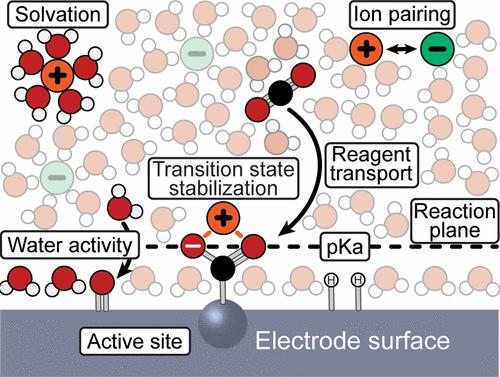当前位置:
X-MOL 学术
›
ACS Energy Lett.
›
论文详情
Our official English website, www.x-mol.net, welcomes your
feedback! (Note: you will need to create a separate account there.)
Trends in Electrocatalysis: The Microenvironment Moves to Center Stage
ACS Energy Letters ( IF 19.3 ) Pub Date : 2023-08-28 , DOI: 10.1021/acsenergylett.3c01623 Marcel Schreier 1, 2 , Paul Kenis 3 , Fanglin Che 4 , Anthony Shoji Hall 5
ACS Energy Letters ( IF 19.3 ) Pub Date : 2023-08-28 , DOI: 10.1021/acsenergylett.3c01623 Marcel Schreier 1, 2 , Paul Kenis 3 , Fanglin Che 4 , Anthony Shoji Hall 5
Affiliation

|
Figure 1. Schematic of the electrode/electrolyte interface, showing the importance of the microenvironment. Figure 2. Schematic showing how the position of the catalyst within the double layer influences charge transfer dynamics. (left) Catalyst shielded by a double layer, behaving like an active site on a metal surface. (right) Catalyst outside of the double layer, behaving like a molecule in solution. Ions/solvents not to scale. We acknowledge Alexander Zielinski for help with figures and Dr. Gong Zhang for input. M.S. acknowledges funding from the Arnold and Mabel Beckman Foundation and from the David and Lucile Packard Foundation. A.S.H. acknowledges financial support from the National Science Foundation, under awards CHE-2102648 and DMR-2047019, and the American Chemical Society Petroleum Research Fund. F.C. acknowledges the National Science Foundation for the partial financial support under award #CBET-2103478. F.C. also acknowledges the partial sponsorship by Department of Navy award N00014-22-1-2001 issued by the Office of Naval Research. We would like to thank all the speakers in our symposium for fostering stimulating discussions. This article references 58 other publications. This article has not yet been cited by other publications. Figure 1. Schematic of the electrode/electrolyte interface, showing the importance of the microenvironment. Figure 2. Schematic showing how the position of the catalyst within the double layer influences charge transfer dynamics. (left) Catalyst shielded by a double layer, behaving like an active site on a metal surface. (right) Catalyst outside of the double layer, behaving like a molecule in solution. Ions/solvents not to scale. This article references 58 other publications.
中文翻译:

电催化的趋势:微环境成为焦点
图 1.电极/电解质界面示意图,显示了微环境的重要性。图 2. 示意图显示双层内催化剂的位置如何影响电荷转移动力学。(左)由双层屏蔽的催化剂,其行为类似于金属表面上的活性位点。(右)双层外的催化剂,其行为类似于溶液中的分子。离子/溶剂未按比例。我们感谢 Alexander Zielinski 在数据方面的帮助以及张功博士的意见。MS 感谢阿诺德和梅布尔贝克曼基金会以及大卫和露西尔帕卡德基金会的资助。ASH 感谢美国国家科学基金会(CHE-2102648 和 DMR-2047019 奖项)以及美国化学会石油研究基金的财政支持。FC 感谢国家科学基金会在#CBET-2103478 奖下提供的部分财政支持。FC 还感谢海军研究办公室颁发的海军部奖 N00014-22-1-2001 的部分赞助。我们要感谢研讨会上的所有发言者促进了激动人心的讨论。本文引用了 58 篇其他出版物。这篇文章尚未被其他出版物引用。图 1.电极/电解质界面示意图,显示了微环境的重要性。图 2. 示意图显示双层内催化剂的位置如何影响电荷转移动力学。(左)由双层屏蔽的催化剂,其行为类似于金属表面上的活性位点。(右)双层外的催化剂,其行为类似于溶液中的分子。离子/溶剂未按比例。本文引用了 58 篇其他出版物。
更新日期:2023-08-28
中文翻译:

电催化的趋势:微环境成为焦点
图 1.电极/电解质界面示意图,显示了微环境的重要性。图 2. 示意图显示双层内催化剂的位置如何影响电荷转移动力学。(左)由双层屏蔽的催化剂,其行为类似于金属表面上的活性位点。(右)双层外的催化剂,其行为类似于溶液中的分子。离子/溶剂未按比例。我们感谢 Alexander Zielinski 在数据方面的帮助以及张功博士的意见。MS 感谢阿诺德和梅布尔贝克曼基金会以及大卫和露西尔帕卡德基金会的资助。ASH 感谢美国国家科学基金会(CHE-2102648 和 DMR-2047019 奖项)以及美国化学会石油研究基金的财政支持。FC 感谢国家科学基金会在#CBET-2103478 奖下提供的部分财政支持。FC 还感谢海军研究办公室颁发的海军部奖 N00014-22-1-2001 的部分赞助。我们要感谢研讨会上的所有发言者促进了激动人心的讨论。本文引用了 58 篇其他出版物。这篇文章尚未被其他出版物引用。图 1.电极/电解质界面示意图,显示了微环境的重要性。图 2. 示意图显示双层内催化剂的位置如何影响电荷转移动力学。(左)由双层屏蔽的催化剂,其行为类似于金属表面上的活性位点。(右)双层外的催化剂,其行为类似于溶液中的分子。离子/溶剂未按比例。本文引用了 58 篇其他出版物。































 京公网安备 11010802027423号
京公网安备 11010802027423号